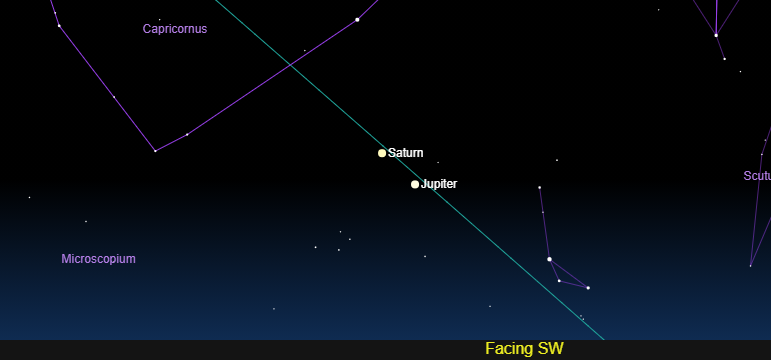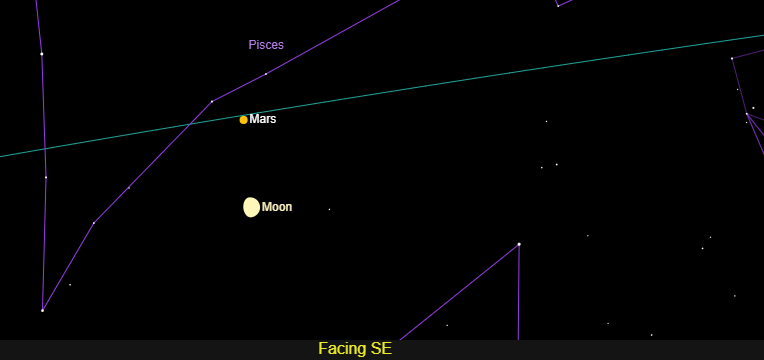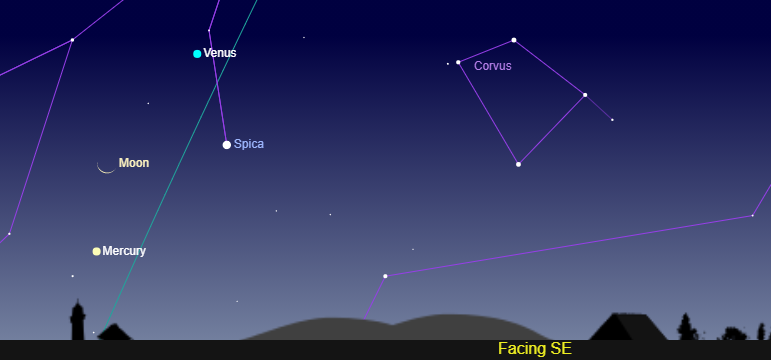As we get into mid to late fall, our parade of planets continues, with the action split between the early evening and dawn skies. All five easily visible planets (or six, if you look down at the ground) can be found with little difficulty this month.
With the change to standard time taking place at the start of November, sunset will take place at 5 o’clock or earlier St. Louis time all month long. As soon as its dark enough, face south to southwest, and Jupiter is immediately seen as the brightest object, about a quarter of the way up in the sky around 6 pm or so. Jupiter shines brightly in our skies because it is the largest planet, and its cloudy atmosphere reflects the Sun’s light very well. Ten power binoculars or a small telescope can show Jupiter’s four largest moons flanking the planets. Much dimmer, but still obvious, is Saturn, which is roughly twice as far away from us as Jupiter. Saturn’s magnificent ring system can be seen using a small telescope. As seen from Earth’s vantage point, Jupiter is in the process of catching up to slower Saturn- the pair appear about five degrees apart at the beginning of November and just two degrees at the end of the month. We will discuss a lot more about their December “Great Conjunction” in next month’s blog entry. The image here, used with the courtesy of Sky & Telescope magazine, shows the look on Thanksgiving evening, November 26. The crescent moon passes through the field on November 18 & 19.

Highlighted in last month’s blog entry, Mars continues its fine evening appearance this month. It cannot be missed as the only really bright orange “star” high in the eastern part of the sky. Falling steadily behind since faster Earth passed it in early October, Mars shines virtually equal to Jupiter’s brilliance at the start of the month, but only about half as bright as the calendar flips to December. Even then, it is still brighter than all stars visible in the night sky save the Dog Star, Sirius, which rises in the southeast in the late evening during November. The hump-shaped gibbous Moon appears near Mars on November 25 (shown below in the S & T image) and farther below it on Turkey Night.

To complete the basket of planets, it is necessary to bundle up a bit and watch around 45 minutes to an hour before sunrise, roughly around 5:45-6 am St. Louis time. Venus, always brightest of planets, is brilliant and unmistakable in the east-southeast with the dawn starting to brighten. This month sees a fine appearance of the innermost planet Mercury, which is at peak visibility from about Nov. 6-20. Mercury appears below and slightly to the left of much brighter Venus. Don’t confuse it with the fainter star Spica, which is to the right around Nov. 6.
Seen low in the sky against the backdrop of early dawn (find an open view to the horizon below Venus!), Mercury often seems to have an orange or pinkish color, which will distinguish it from white Spica. The map below is set for the morning of the 13th, when the waning crescent moon joins the impressive and crowded scene, but it will be useful through the whole period of Mercury’s visibility.

The Gateway to the Stars program is complete for 2020. We plan to resume in May 2021 with a schedule of stargazing and astronomy education programs. Depending upon the state of the pandemic, these may be virtual or in person.
